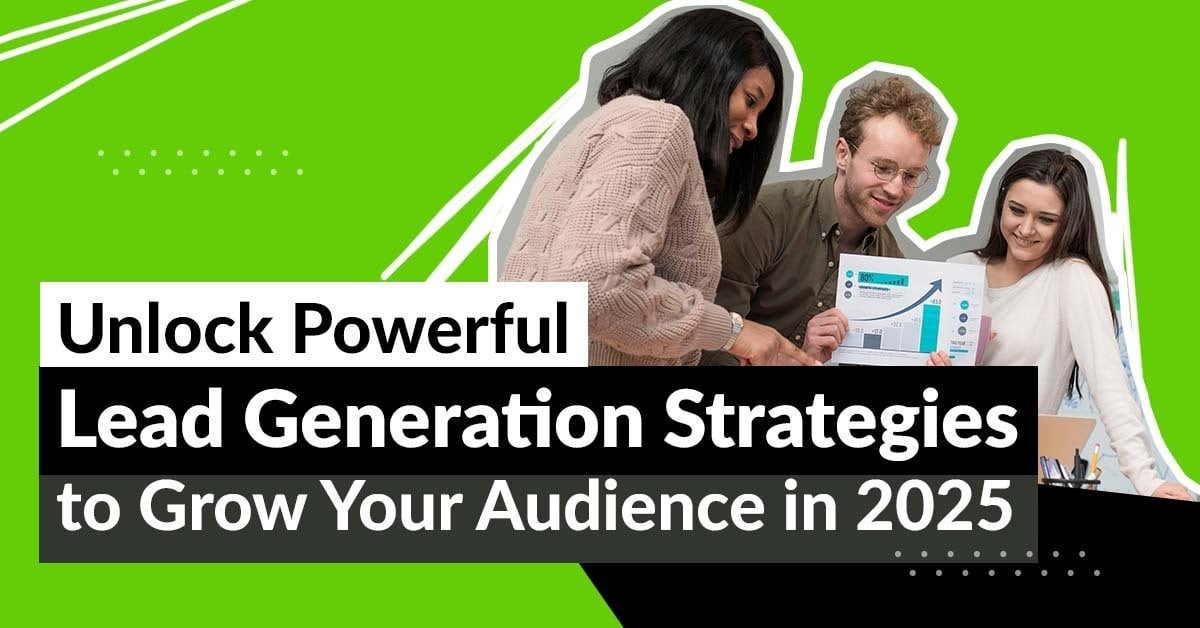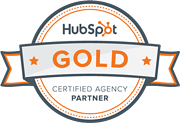Lead generation is the backbone of business growth, but in 2025, the landscape is evolving at an unprecedented pace. Generating high-quality leads remains a top priority for 91% of marketers, highlighting its significance in achieving business success.
As consumer behavior shifts and technology advances, businesses must continuously refine their lead generation approaches to stay ahead. Cutting-edge AI innovations, automated workflows, and data-centric strategies have reshaped how brands attract and engage prospects, rendering conventional approaches increasingly obsolete.
Meanwhile, increasing privacy regulations and the phasing out of third-party cookies are reshaping data collection practices, pushing businesses to prioritize ethical, first-party data strategies to build trust and drive conversions.
Modern consumers expect highly personalized and interactive experiences, making conventional lead generation tactics — such as cold outreach and generic email campaigns — less effective. Organizations that do not evolve with these shifts may find themselves overshadowed by competitors who harness technology, data analytics, and customer-first strategies to drive growth.
To stay ahead, businesses must leverage emerging trends and innovative tools to generate and nurture leads efficiently. Lead generation trends in 2025 emphasize AI-driven automation, first-party data collection, and personalized marketing to attract and convert high-quality leads.
Inside This Guide: Key Lead Generation Strategies for 2025
In this post, we will explore six powerful lead generation strategies to scale your business in 2025. These strategies can help businesses expand their audience and drive meaningful engagement.
From leveraging AI for smarter lead capture to building authority through community engagement, these strategies will provide a competitive edge in an increasingly digital and customer-driven market.
Embracing these modern growth marketing tactics enables businesses to streamline their efforts, foster stronger connections with customers, and secure sustainable growth well into 2025 and beyond.
Implementing effective lead nurturing strategies for ecommerce ensures that potential customers receive personalized engagement through targeted emails, product recommendations, and retargeting campaigns, ultimately driving higher conversions and customer retention.
What is Lead Generation?
Lead generation is the strategy businesses use to attract and capture potential customers interested in their products or services. Instead of depending only on cold outreach, businesses leverage multiple marketing channels — including content marketing, social media, and paid ads — to attract and engage potential customers more effectively.
A strong lead generation approach helps businesses build a steady stream of qualified leads, improving conversion rates and ensuring long-term growth. By nurturing these prospects with personalized interactions, businesses can turn interest into actionable sales opportunities.
This approach generally requires gathering key details from prospective customers — like their name, contact information, or company insights — by offering them valuable resources or exclusive incentives in return. This can be done through various methods, including website forms, gated content (eBooks, whitepapers, webinars), social media lead generation strategies (interactions), and online lead generation ads. Businesses then nurture these leads through personalized marketing campaigns, guiding them toward making a purchase decision.
Lead Generation Ideas to Grow Your Audience in 2025
In 2025, businesses that integrate data-driven, customer-centric approaches will see higher engagement and better conversion rates.
Here are some powerful lead generation ideas to help grow your audience and drive business success in 2025.
Leverage AI and Automation for Smarter Lead Capture
Are you wondering how to use AI for generating leads in 2025? Artificial Intelligence (AI) and automation are transforming the way businesses capture and nurture leads. AI for lead generation is becoming an essential strategy as traditional, manual data collection and follow-ups are no longer efficient.
In 2025, relying on manual data collection and follow-ups is no longer efficient — AI-powered tools now enable businesses to identify, engage, and qualify leads in real time.
AI-powered chatbots and virtual assistants have become essential tools for lead generation, enabling businesses to instantly engage with prospects, gather valuable customer data, and seamlessly guide them through the sales journey.
Unlike traditional customer service teams that operate during business hours, AI chatbots work 24/7, ensuring that businesses never miss an opportunity to engage potential leads. AI chatbots for lead capture help businesses qualify prospects, automate follow-ups, and deliver personalized interactions, improving conversion rates and overall efficiency.
AI-driven lead scoring and segmentation systems use predictive analytics for lead generation to determine which prospects are most likely to convert, allowing sales teams to focus their efforts on high-value leads rather than wasting time on unqualified ones.
Beyond chatbots, AI-powered marketing automation tools streamline the entire lead nurturing process by delivering personalized email sequences, social media interactions, and targeted content recommendations. Implementing effective lead nurturing tactics ensures that potential customers remain engaged throughout their buyer journey, increasing the chances of conversion.
These tools analyze user behavior — such as website visits, content downloads, and email interactions — to tailor marketing messages that align with each prospect’s interests. For example, an ecommerce business can use AI to recommend products based on past browsing history, while a B2B lead generation strategy for a SaaS company can trigger automated follow-up emails based on a lead’s engagement with a webinar.
This level of hyper-personalization not only enhances user experience but also increases conversion rates significantly. Leveraging AI and automation in lead generation allows businesses to streamline processes, enhance productivity, and attract more qualified leads while minimizing the need for continuous hands-on management.
Optimize First-Party Data Collection & Personalization
With the decline of third-party cookies and stricter data privacy regulations, businesses must redefine their approach to customer data by prioritizing first-party data collection. This shift not only ensures compliance with regulations like GDPR and CCPA but also empowers brands to establish direct, trustworthy relationships with their audiences.
Unlike third-party data, which is often collected without explicit user consent and lacks accuracy, first-party data is willingly shared by customers, making it more reliable, relevant, and actionable. By gathering insights through website interactions, email sign-ups, purchase history, and customer feedback, businesses can continue delivering personalized experiences without compromising privacy.
However, collecting first-party data alone isn’t enough — how it is collected matters just as much as what is collected. Ethical data collection practices are crucial in building customer trust and long-term loyalty.
Brands must be transparent about their data practices, clearly explaining why they are collecting information and how it benefits the user. This transparency, coupled with value-driven incentives, can encourage customers to willingly share their information.
Offering gated content (such as exclusive reports or webinars), creating loyalty programs that reward engagement, and implementing preference-based surveys that allow users to customize their experience are all effective ways to collect first-party data responsibly.
Personalization remains at the core of converting leads into loyal customers. Harnessing first-party data enables businesses to optimize their marketing approaches, crafting highly relevant messages that reach the right audience at the most impactful moments.
Dynamic website content can adjust based on a visitor’s previous interactions, AI-powered product recommendations can enhance shopping experiences, and behavior-based email marketing for lead generation can nurture leads by delivering tailored offers and content.
Nearly half of marketers (48%) consider email marketing their most powerful tool for generating leads, while 44% prioritize website landing pages and 43% rely on content marketing to attract potential customers.
Retargeting campaigns fueled by first-party data allow businesses to stay top-of-mind with potential customers without relying on third-party tracking mechanisms. By integrating data-driven personalization and advanced retargeting strategies, businesses can boost engagement, enhance user experience, and ultimately drive higher conversion rates in a privacy-first digital landscape.
Interactive Content & Gamification for Higher Engagement
Traditional lead generation methods, such as static forms and generic email sign-ups, are becoming less effective as modern consumers expect more engaging and value-driven interactions. Interactive content for lead generation bridges this gap by providing an immersive and enjoyable experience while simultaneously capturing essential lead data.
Unlike traditional content that relies on passive consumption, quizzes, polls, calculators, and interactive infographics encourage users to actively engage with the brand. A fashion brand could offer a virtual styling assistant that suggests outfits based on user preferences, while a SaaS business might develop a savings estimator to showcase the cost advantages of its platform. These tools not only keep users engaged longer but also offer businesses deep insights into customer preferences, enabling more personalized follow-up strategies.
Gamification in marketing builds upon this interactive approach by adding motivational elements that trigger emotional responses, making the lead generation process more compelling. The use of badges, points, progress tracking, and leaderboards taps into basic human psychology, where people feel driven by achievement, competition, and rewards.
This technique is particularly effective in industries such as education, fitness, and finance, where users benefit from tracking their progress and receiving incentives for continued engagement. For example, Duolingo, a language-learning app, gamifies the experience with streaks and rewards, keeping users motivated to return daily. Similarly, brands that implement referral challenges (referral programs for lead generation) or exclusive rewards for participation can see a significant boost in lead generation, as customers are more likely to share these experiences with their networks.
By leveraging interactive content for lead generation and gamification, businesses can create meaningful connections with their audience, drive higher conversion rates, and turn casual visitors into loyal customers.
Demand Generation Through Community & Social Selling
Social selling and online communities are more than just platforms for engagement — they serve as relationship-building ecosystems where businesses can establish long-term connections with potential customers. Unlike traditional marketing, which often relies on one-way communication, community-driven interactions allow for meaningful two-way conversations.
When businesses actively listen to their audience’s pain points and provide genuine, helpful solutions, they create trust and brand loyalty. For example, a SaaS company participating in LinkedIn or Slack communities can offer free resources, expert advice, and product insights that position them as an industry authority without pushing for a sale.
Over time, this approach warms up potential leads and increases their likelihood of converting when they need a solution.
Moreover, leveraging social proof and influencer collaborations significantly enhances demand generation efforts. When trusted industry figures, thought leaders, or respected community members endorse a brand, it carries far more weight than traditional advertisements.
Businesses can collaborate with micro-influencers, industry experts, or even satisfied customers who already have credibility within a community to amplify their message. For instance, a cybersecurity company partnering with a well-known IT security expert to host a live Q&A session in a LinkedIn group can drive interest and engagement from highly relevant leads.
Additionally, encouraging user-generated content, testimonials, and case studies within these communities can further establish brand authenticity, making prospects feel more confident in their decision to engage with the brand. By integrating community engagement, social selling, and influencer partnerships, businesses can create a powerful demand generation tactic that nurtures leads organically.
Conversion-Optimized Landing Pages & Lead Magnets
A well-designed landing page (an ideal landing page design for conversion) is one of the most powerful lead generation tools of 2025 for converting visitors into leads. Landing pages are strategically crafted to focus on a single objective, guiding visitors toward a desired action such as registering for an event, accessing exclusive content, or completing a transaction.
To boost conversion rates, businesses should prioritize essential components like an attention-grabbing headline, a concise yet impactful value proposition, a strong and actionable CTA, and a user-friendly design. Additionally, minimizing distractions (such as unnecessary links or excessive navigation options) can help keep visitors focused on the desired action.
Implementing A/B testing on high converting landing pages — experimenting with different CTAs, headlines, and page structures — can provide insights into what resonates most with the target audience, allowing for continuous optimization.
Lead magnets are equally crucial in capturing high-quality leads by offering valuable resources in exchange for contact information. Businesses can offer valuable resources such as guides, reports, toolkits, demo access, success stories, and expert-led virtual events to engage and convert prospective customers. However, the effectiveness of a lead magnet depends on its relevance to the target audience — it must address a specific pain point or need.
For instance, a B2B software company might offer a free industry report that provides actionable insights, while an ecommerce business could provide a discount code or personalized shopping guide. To further enhance engagement, businesses should consider interactive lead magnets like interactive quizzes for lead generation or assessments that provide personalized results, encouraging users to take the next step in the customer journey.
By combining conversion-optimized landing pages with strategic lead magnets, businesses can significantly increase lead generation and nurture potential customers more effectively.
Final Thoughts
As the digital landscape evolves, businesses must embrace innovative lead generation strategies to stay competitive. The marketing tactics that worked in the past are no longer sufficient — today’s consumers demand personalized, engaging, and seamless experiences before they share their information or make a purchase.
In 2025, AI-powered automation, ethical first-party data collection, interactive content, social selling, and conversion-optimized landing pages will play a crucial role in attracting, nurturing, and converting leads into loyal customers. Companies that ignore these evolving tactics may struggle to attract and retain potential customers, falling behind rivals who leverage cutting-edge marketing innovations.
To successfully implement these strategies, businesses should focus on the following:
- Invest in AI-driven tools to automate lead capture, scoring, and nurturing, ensuring real-time engagement with potential customers.
- Prioritize ethical data collection by focusing on first-party data, ensuring compliance while enhancing customer trust and personalization.
- Leverage interactive content and gamification techniques to engage users, capture leads, and provide a more immersive brand experience.
- Establish authority within online communities and social platforms, using social selling and influencer collaborations to build credibility and attract high-quality leads.
- Continuously optimize landing pages and lead magnets, using A/B testing and data-driven insights to maximize conversions and enhance user experience.
By adopting these innovative strategies, companies can grow their customer base while fostering lasting connections with highly qualified prospects. Now is the time to refine your lead generation approach, integrate cutting-edge technologies, and position your brand for sustainable success in 2025 and beyond. You can also hire an established agency to streamline the process and leverage expert insights for maximum impact.










